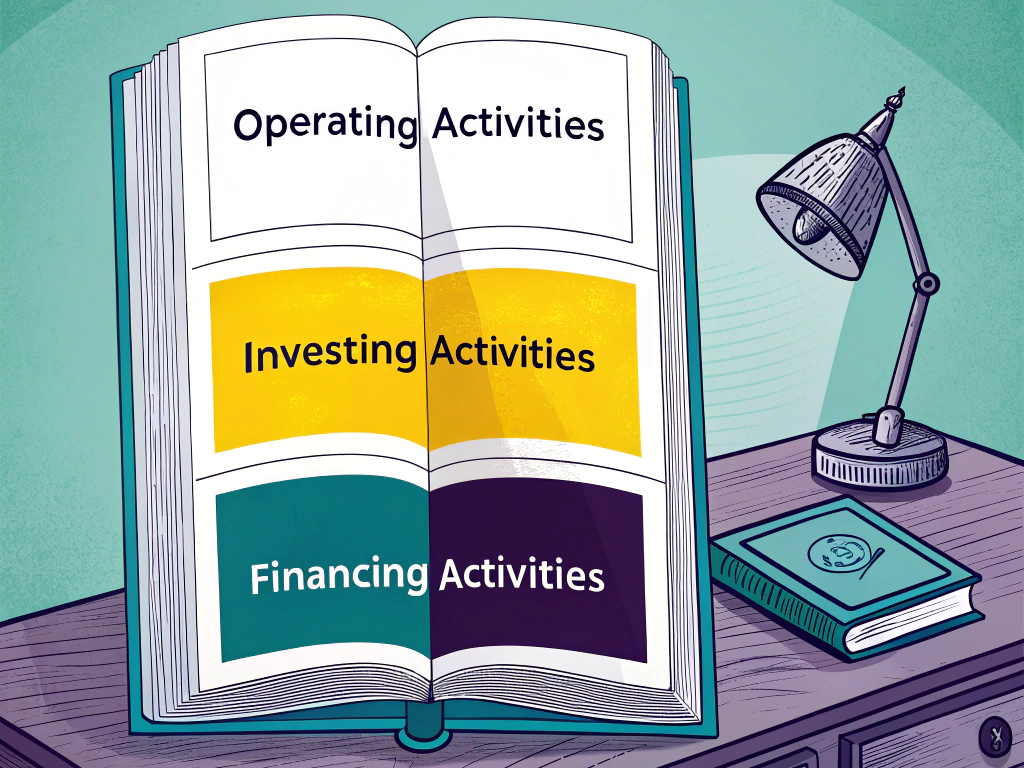Statement of Cash Flows: What It Is and Why It Matters
Listen up, future financial wizards and entrepreneurial rockstars! Ever wonder if a company is actually making money or just putting on a good show? That’s where the statement of cash flows—or as we like to call it, the cash flow statement—steps into the spotlight. Think of it as the ultimate truth serum for a company’s finances, showing the real cash flowing in and out over a specific period.
Even the all-mighty Securities and Exchange Commission (SEC) says, “Show me the money!”—requiring every company that sells stocks to the public to spill the beans with their financial statements. That means the balance sheet, income statement, cash flow statement, and the ever-so-exciting statement of comprehensive income. Yes, all the juicy details.
This financial gem isn’t just for show—it’s your go-to tool to assess a company’s liquidity (can they pay their bills without breaking a sweat?), solvency (are they swimming or sinking in debt?), and their mighty ability to generate that sweet, sweet cash.
In other words, the cash flow statement lets investors and creditors peek behind the curtain to see if a company can actually foot its bills or if it’s just juggling numbers. It’s like a financial health check-up, showing how well the company is managed and how efficiently it’s running the show. No smoke and mirrors here—just cold, hard cash facts.
What is a Statement of Cash Flows?
The statement of cash flows is a financial statement that shows how much cash a company has on hand, where that cash came from, and where it went over a certain period of time. It’s also called the cash flow statement. Think of it as a snapshot of a company’s cash inflows and outflows during what’s known as the reporting period. It’s typically used to assess a company’s financial health and liquidity, as well as its ability to pay its bills and meet its short-term obligations.
This statement is your secret weapon to understand a company’s financial heartbeat. It reveals:
- Liquidity: Can they pay their bills without sweating bullets?
- Solvency: Are they drowning in debt or cruising comfortably?
- Cash Generation: Are they actually making money or just shuffling numbers?
Ignore this statement, and you might as well be throwing darts in the dark. Knowledge is power, my friends.
What Does the Cash Flow Statement Show?
The statement of cash flows breaks down the company’s cash movements into three main sections: operating activities, investing activities, and financing activities. It shows how much cash the company has generated or used over a certain period from these activities. The main purpose of a cash flow statement is to help manage the company’s financial affairs and make informed decisions about investing, financing, and other activities.
Breaking Down the Statement of Cash Flows
Alright, let’s break it down like a DJ at a finance party. The cash flow statement is split into three action-packed sections: Operating Activities, Investing Activities, and Financing Activities. Think of them as the trilogy that tells the complete story of where your cash is coming from and where it’s sneaking off to. Let’s dive into each one, shall we?

Operating Activities: The Day-to-Day Moneymakers
This is where the magic happens, folks. Operating activities cover all the cash flowing in and out from the company’s core business operations—think of it as the heart pumping blood (cash) through the veins of your business. It’s all about the cash generated from selling goods or services and the cash spent on things like inventory, salaries, and utilities.
In other words, this section is the financial diary of your daily hustle. It tracks cash coming in from sales (cha-ching!) and cash going out for expenses like rent, payroll, and keeping the lights on. It’s the gritty, real-life story of your company’s operations, minus the Hollywood glamour.
So when you’re selling your awesome products or services, that’s cash in. When you’re buying inventory, paying your team, or covering rent—yep, that’s cash out. It’s the cash dance of business life, and this section captures every step.
Examples of Operating Activities on the Cash Flow Statement
- Sales Revenue: The sweet cash from products or services you’ve sold.
- Sale of Inventory: Turning your stock into money—always a good feeling.
- Purchase of Inventory: Gotta spend money to make money, right?
- Salaries Expense: Paying your hardworking team (high-fives all around).
- Rent Expense: Keeping a roof over your business’s head.
Investing Activities: Playing the Long Game
Next up, we’ve got investing activities—the financial equivalent of planting seeds for future growth. This is where the company spends or receives cash from buying or selling long-term assets like property, plants, or equipment. It’s about thinking ahead, making those strategic moves that (hopefully) pay off down the line.
To put it plainly, investing activities are all about the cash used or gained from long-term investments. Buying new machinery? That’s cash out. Selling off old equipment? That’s cash in. This section is your go-to spot for tracking capital expenditures (CapEx), which is just a fancy way of saying “big-ticket items that keep the business moving forward.”
Examples of Investing Activities on the Cash Flow Statement
- Sale of Property: Cashing in on real estate—maybe that office was too big anyway.
- Purchase of Property: Expanding your empire, one building at a time.
- Sale of Plant: Selling off facilities—for when you’re streamlining operations.
- Purchase of Plant: Investing in new facilities—because growth is the name of the game.
- Sale of Equipment: Out with the old, in with the new (or just out with the old).
- Purchase of Equipment: Upgrading your gear—who doesn’t love new toys?
Financing Activities: The Money Shuffle
Finally, we’ve got financing activities—the grand finale of cash flow. This section is all about how the company finances its operations (duh!). Are they borrowing money, repaying debts, issuing new stock, or paying dividends? It’s like watching the company’s financial strategy unfold in real-time.
In this part of the statement, you’ll see big moves like taking out loans (cash in), paying off debts (cash out), issuing stock to raise funds (cash in), or paying dividends to keep shareholders smiling (cash out). It’s the company’s financial juggling act, and you’re invited to watch.
Examples of Financing Activities on the Cash Flow Statement
- Loans Taken: Getting that cash infusion—sometimes you gotta borrow to grow.
- Loan Repayment: Paying back what you owe—because nobody likes a late payer.
- Issuance of New Equity: Bringing in new investors—welcome to the party!
- Payment of Dividends to Shareholders: Sharing the wealth with those who believed in you.
- Buyback of Shares: (Treasury Stock) Snapping up your own stock—because sometimes you just can’t get enough of yourself.
So, to sum it up, financing activities are all about the cash ins and outs from raising or repaying capital. It’s the company’s financial dance, and it’s as revealing as it is fascinating.
Peeking into a company’s cash flow statement is like having X-ray vision into its financial soul. If they’re constantly shelling out more cash than they’re raking in from operations, that’s a big red flag waving in your face. It might mean they’re heading for trouble and could struggle to stay afloat in the long run. Time to raise an eyebrow—or maybe both.
Purpose of the Cash Flow Statement
So, what’s the grand purpose of the cash flow statement? It’s to give investors and creditors the down-low on the company’s financial health and liquidity. For those investors chasing growth stocks, a company splurging on capital expenditures (CapEx) is like finding a unicorn—it’s a sign they’re investing in future growth. Translation: They’d love to see positive cash flows from investing activities. On the flip side, investors hunting for income stocks are all about that positive cash flow from operating activities. Show them the money coming in from day-to-day operations, and they’re happy campers.
In short, if you’re into income stocks, the operating activities section is your new best friend. If you’re eyeing growth stocks, head straight to the investing activities section. Different strokes for different folks, as they say.
As for the creditors—those fine folks who lend money—they’re laser-focused on the financing activities section. They want to know if you’re paying back debts or just watching Netflix. Plus, this section spills the beans on whether you’re paying dividends or buying back shares (hello, treasury stocks). It’s all the juicy details they need to sleep well at night.
Preparation of Cash Flow Statement
Now, how do you whip up a cash flow statement? Great question! There’s some number-crunching involved, but don’t panic—we’ve got two main methods to get the job done: the indirect method and the direct method. Both roads lead to Rome (or in this case, to the truth about your cash flows), but they take slightly different routes. Let’s explore how each one works and what sets them apart.

Statement of Cash Flows Indirect Method
The indirect method of preparing a cash flow statement involves starting with the net income for the period and then adjusting it for non-cash items that affected net income. These items include depreciation, amortization, deferred taxes, and other non-cash goodies. This results in the cash provided by operating activities. It uses the accrual method of accounting, which records sales when earned—not necessarily when the cash is received. Because who needs immediate gratification?
This means the indirect method adjusts net income for the changes in balance sheet accounts to calculate the cash flow from operating activities. Regulatory boards generally accept this method because it provides more info about a company’s operating cash flows than the direct method. More info equals better decisions, right?
How to Prepare a Statement of Cash Flows Using the Indirect Method
First up, adjust net income for items that do not affect cash. These non-cash items include depreciation and amortization. Adding back these expenses gives us the company’s operating profit before interest and taxes (EBIT). It’s like cleaning up the numbers to reveal the real cash flow hero.
Next, adjust EBIT for changes in other working capital items on the balance sheet. These include accounts receivable, inventory, and accounts payable. Adjusting for these changes tells us how much cash was generated (or used) by the company’s operations during the period. It’s like the plot twist in a financial thriller.
Finally, add any interest and tax payments made during the period to arrive at the total cash flow from operating activities. Voila!
The goal of the indirect method is to ultimately arrive at the same cash flows that would be reported using the direct method. Different path, same destination.
Statement of Cash Flows Direct Method
The direct method of preparing a cash flow statement is the straightforward route—simple, easy to understand, and provides detailed info about a company’s cash flow. It uses the cash method of accounting where the actual cash received is recorded. No funny business.
The difference between the indirect method and the direct method lies in how the operating activities are reported. Other sections like investing and financing activities are reported the same way in both methods. So really, we’re just talking about a different flavor for the same ice cream.
How to Prepare a Statement of Cash Flows Using the Direct Method
To prepare a cash flow statement using the direct method, list all major cash receipts and payments for the period. These items are then categorized as operating activities, investing activities, or financing activities. Easy peasy.
Operating activities include items like cash collected from customers, cash paid to suppliers, and cash paid to employees. Investing activities cover cash received from the sale of investments and cash paid for new investments. Financing activities include cash received from issuing new debt and cash paid to repay outstanding debt.
Once all major cash inflows and outflows have been accounted for, calculate the net change in cash for the period—the difference between the cash inflows and outflows from operating activities. Simple math, big insights.
The direct method is the most straightforward way to prepare a cash flow statement because it simply lists all of the cash inflows and outflows for the period in question. This info can be gleaned from a company’s accounting records. No detective work required.
Cash Flow Statement: Positive and Negative Flows
A cash flow statement could be positive or negative, depending on the difference between the cash inflows and outflows. This difference determines whether a company can operate in the short or long term. A positive cash flow shows the company is solvent and can grow its operations. A negative cash flow isn’t necessarily doom and gloom, but it does warrant a closer look.

Positive Cash Flows
A positive cash flow simply means more cash is coming in than going out. Sounds good, right? Let’s break it down.
Positive Cash Flow from Operations
Positive cash flow from operating activities means the core activities of the business are generating more cash than they’re spending. This is music to investors’ ears. However, note that a business can still have a positive cash flow from operations and not be profitable. Cash flow statements report the movement of cash—not profitability.
Positive Cash Flow from Investing Activities
A positive investing cash flow means the company is generating cash from investments (gains) or cash is received from the sale of property, plant, or equipment. While positive cash flow from investing activities is good, it’s not the main activity of the business and shouldn’t be the major source of cash. Investors prefer companies to generate cash through their main operations.
Positive Cash Flow from Financing Activities
Positive financing cash flow means cash is generated from the sale of equity (shares), taking loans, or the company may not have paid dividends during the accounting period. The reason for positive cash flow from financing activities determines whether it’s good or bad. For an investor looking for income stocks, a positive cash flow from financing activities due to a lack of dividend payments might be appealing.
Negative Cash Flow
A negative cash flow means more cash is going out than coming in. It’s not a measure of profitability, so a company can have negative cash flow and still be profitable. But it’s a signal to dig deeper.
Negative Cash Flow from Operations
Negative cash flow from operating activities means more cash is spent on core activities than received. It doesn’t mean the company isn’t generating sales—accounts receivable might be high (sales made but cash not received). This is why the indirect method adjusts net income for non-cash items like accounts receivable to arrive at operating cash flow.
Therefore, negative cash flow from operations could mean:
- More cash is used for paying salaries than cash received from other operational activities.
- More cash is used for purchasing inventory than cash received from sales.
- Sales are made but cash is yet to be received (high accounts receivable).
- Low sales but higher spending arising from other operating activities.
Negative Cash Flow from Investing Activities
Negative cash flow from investing activities means the business is spending more on investments or acquiring property, plant, or equipment. This often indicates the firm is investing in growth—a positive sign. However, it could also mean losses from investments. Always check the reason behind the negative flow.
Negative Cash Flow from Financing Activities
Negative financing cash flow means more money is spent on repaying debts, paying dividends, or buying back shares (stock buybacks). It could be a sign of financial health, but context is key.
A negative cash flow statement isn’t always bad—a company might be investing in research and development or growth initiatives. It’s wise to check multiple cash flow statements to understand the overall spending trends. And remember, negative cash flow doesn’t mean the absence of profits.
Importance of the Statement of Cash Flows
- Tracking Cash Movement: It lets the company monitor how much cash is coming in and going out, enabling better financial decisions.
- Identifying Red Flags: It helps spot potential financial problems before they become critical.
- Investor Insight: Investors can see if a company generates more revenue than expenses, indicating efficient financial management.
- Capital Expenditures: It tracks funds used for purchasing and maintaining fixed assets—key for assessing growth potential.
- Stock Valuation: It aids in determining the value of a company’s stocks.
- Dividend Payments: It shows the amount of money paid out as dividends—important for income-focused investors.
- Creditor Confidence: Creditors can assess if the company is actively repaying loans.
- Share Buybacks: It reveals money used for share buybacks, indicating confidence in the company’s future.
